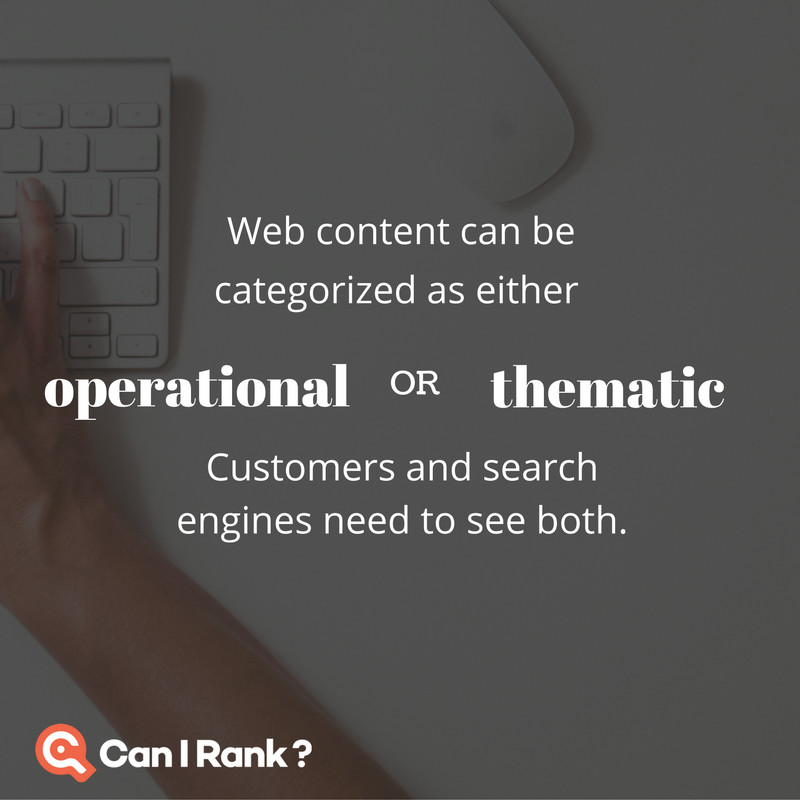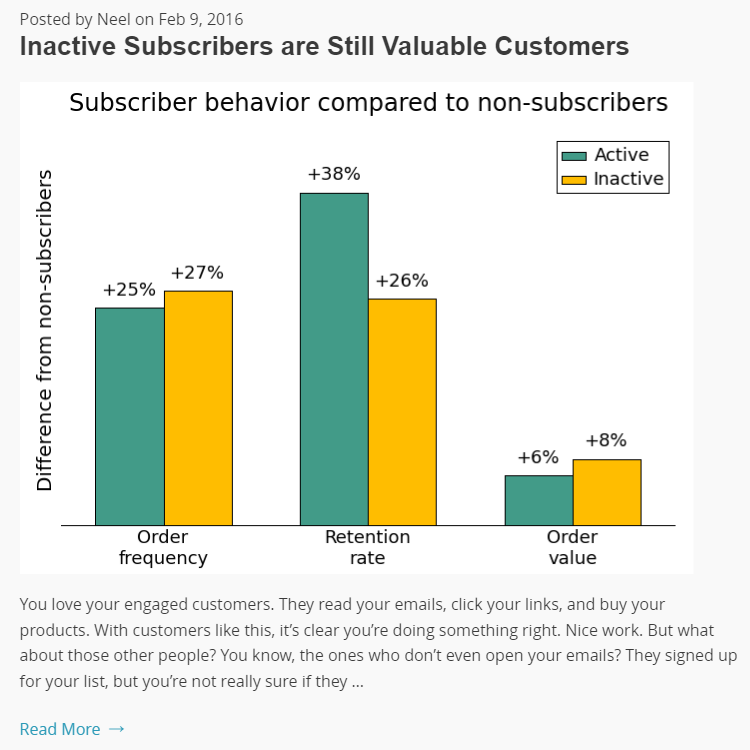We constantly hear that “content is king” within the world of digital marketing. And most marketers understand the ongoing need to craft thoughtful, original content for the sake of our site’s search presence and readership.
But what happens when we get fed up with our lack of links and tepid traffic that doesn’t convert?
For a content marketer, there’s nothing more disheartening than putting so much of ourselves into our websites and blogs only to get nothing in return. We’re all searching for ways to help get our blog content noticed.
So how do we put a stop to the stress and start seeing an ROI for our content marketing efforts?
Operational Content vs Thematic Content
Here’s the deal: not all content is created equal.
While we should obviously strive to write the best pieces possible for our sites, it’s time to stop thinking about creating “content” for the sake of creating content. Instead, think about the true function of on-site content.
The first step to optimizing your site’s content is breaking it down and understanding its function for users on the page and search engines.
On any given site, content can be categorized as either operational or thematic.
Operational content represents your business’ most vital information. For example, let’s say you’re a plumber in Toledo, Ohio and have a website dedicated to your business. Your operational content would include the descriptions of your service area, fees, location, contact information and so on.
Think of operational content as the “bare necessities” in terms of what visitors would need if they wanted to hire you. While there aren’t many opportunities to get “creative” or build links through such information, operational content is certainly valuable in terms of your site’s usability and customer experience.
The Untapped Potential of Thematic Content
Thematic content is a whole other story.
Literally.
Thematic content represents the meat of your site, including product and service descriptions, ratings and reviews, case studies and explanations of your business’ practices. Such content represents a potential SEO goldmine, prime for targeting keywords, building backlinks and demonstrating value to your visitors. As further proof, thematic content is the go-to strategy of ecommerce SEO experts to drive sales and traffic.
If your website is suffering in terms of traffic or domain authority, chances are that your thematic content is lacking.
For example, the aforementioned Toledo plumber could work to target geo-specific keywords (such as “best Toledo plumber” or “plumbers in Toledo”) throughout their thematic content. Meanwhile, writing helpful do-it-yourself articles such as “how to prevent frozen pipes: or “how to install a touchless kitchen faucet” work to demonstrate that business’ knowledge, expertise and willingness to help customers.
Not to dive into too much of the technical jargon, but adding in this broad foundation of topic related content helps to boost the use of LSI keywords throughout your site. LSI keywords, essentially, refer in SEO terminology to synonyms or related terms. By including a spectrum of related terms throughout the content on your site, it helps paint a bigger and clearer picture for Google, as to what your site is about. If crawlers spot the term “plumbing” on your site, they might wonder whether you sell plumbing parts, whether you offer plumbing services, or maybe you teach plumbing courses. By expanding your thematic content to related topics, the LSI keywords you use throughout all this content helps Google determine more precisely what you do and what kind of SERPs to include you in.
The former provides opportunities to rise in the SERPs, while the latter creates back-linking opportunities which are positive signals to search engines.
In short, thematic content proves to search engines that your site is relevant to your respective niche or industry and establishes your site as a useful resource to users.
Transforming Your Thematic Content
Beefing up your thematic content is more than likely the missing piece of your content marketing strategy if you’re looking to rise above your competition or shine in the eyes of search engines.
Chances are you have some work to do on your own site, but where do you start?
There is no one-size-fits-all strategy to content creation and optimization; however, there is more than likely immediate action you can take to improve your site’s thematic content today.
By exploring some case studies and understanding the good and bad of thematic content, you’ll have a better concept of what optimized content actually looks like. Check out these two SEO Silo case studies, one for an SaaS startup and theother for an eCommerce site, or our case study on why longer content ranks better for more ideas.
The Anatomy of Optimized Content
Oftentimes when we think “optimization,” our minds are flooded with images of alt-tags, internal links and the more technical aspects of content creation. While such elements are crucial to providing search engines with hints of what your site is all about, technical optimization isn’t the be-all, end-all of ranking for keywords. At the end of the day, you’ll need a substantial amount of thematic content to back up your efforts as you scale your marketing.
Instead of stressing out, strive to create the best content possible for the sake of your site and business. Brainstorm ways in which you bolster your site by crafting thematic content that is…
- Unique – Instead of simply spinning what’s already out there, write something new. Whether you’re providing fresh commentary or simply covering a topic that others in your industry have neglected, ask yourself: what separates my content from that of the hundreds of other sites in my space?
- Keyword-rich – Don’t interpret “keyword-rich” as “spam.” Thematic content should include keywords that are relevant to what your customers are looking for and therefore should appear naturally in your content.
- Genuine – Churning out junk content will get you nowhere with customers and search engines alike. Instead, put in the effort to put out genuinely useful content that earns links and signals your site as a helpful resource for customers.
- Fresh – Content creation is an on-going process. By consistently adding fresh pieces to your site, you better poise yourself to get in front of more eyes and show your customers that you’re a human looking to help them out.
- Good length – Though the effects are unproven and often quite small, research has shown that Google rewards longer content directly in their algorithm.
Although it does require an investment of your time, the benefits of thematic content ultimately work to establish your site’s credibility and expertise in the long-run. Don’t worry about “giving away your secrets” but rather show customers that you are the resource they need the job done, whatever that job may be.
Thematic Content in Action
Content creation is often easier said than done, especially if you find yourself in a highly technical or “boring” niche where creativity seems hard to come by. If you’re still strapped for ideas, consider:
- What’s new or changing within your industry
- Detailed tutorials and how-to articles to help educate customers
- White papers or original research that showcase your expertise
- Statistics or data you’ve collected that may be eye-opening to your readership
- Interviews with industry experts and customers
- Product reviews relevant to your readers
Consider also how successful brands use thematic content to satisfy their hungry readership:
- Blendtec attracted over 10,000 links and 100,0000 “likes” for their “Will It Blend?” video series
- LinkedIn utilizes user-data to drive their own content regarding job trends and employment statistics
- TireRack.com attracted over 20,000 links and hundreds of thousands of views in a relatively “mundane” industry by putting various tires to the test
- Email service MailChimp regularly discusses the best practices of email marketing for customers to make their efforts don’t go to waste
- Dating service OKCupid.com mines its own member profiles to create data-driven insights into romantic behavior
I’m Ready to Write: Now What?
Thematic content production works best if at least one person is responsible for the task. While content creation can be a daunting prospect, consider marketers within your organization who excel at writing or whether or not it’d be realistic to tackle the task yourself.
Hiring a freelance blogger or journalist on a freelance-basis is also an attractive option for those looking for an expert yet don’t want to commit themselves to a full-time employee. For example, sites such as Upwork allow you access to writers willing to provide content at a competitive rate. While it’s possible to find content creators on the cheap, between $15-20 per post, you often get what you pay for in terms of micromanaging such writers and having to make edits yourself. To ensure the highest quality for your customers, make sure to seek out a professional with a proven portfolio and track record within your niche.
Thematic content represents the foundation of your site for both customers and search engines. By embracing the creation of compelling, clickable content, you’ll establish your site as a valuable resource for customers in the long-run.
How to Save Your Website by Beefing Up on Thematic Content Click To Tweet







Leave A Comment